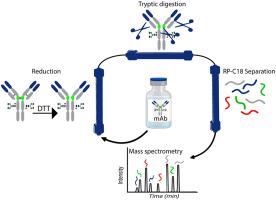Analytica Chimica Acta ( IF 5.7 ) Pub Date : 2021-09-02 , DOI: 10.1016/j.aca.2021.339015 Sanne Pot 1 , Christoph Gstöttner 1 , Katrin Heinrich 2 , Sina Hoelterhoff 3 , Ingrid Grunert 2 , Michael Leiss 2 , Anja Bathke 3 , Elena Domínguez-Vega 1

|
Characterization of post-translational modifications (PTMs) of therapeutic antibodies is commonly performed by bottom-up approaches, involving sample preparation and peptide analysis by liquid chromatography-mass spectrometry (LC-MS). Conventional sample preparation requires extensive hands-on time and can increase the risk of inducing artificial modifications as many off-line steps - denaturation, disulfide-reduction, alkylation and tryptic digestion - are performed. In this study, we developed an on-line multidimensional (mD)-LC-MS bottom-up approach for fast sample preparation and analysis of (formulated) monoclonal antibodies and antibody-derived therapeutics. This approach allows on-column reduction, tryptic digestion and subsequent peptide analysis by RP-MS. Optimization of the 1D -and 2D flow and temperature improved the trapping of small polar peptides during on-line peptide mapping analysis. These adaptations increased the sequence coverage (95–98% versus 86–94% for off-line approaches) and allowed identification of various PTMs (i.e. deamidation of asparagine, methionine oxidation and lysine glycation) within a single analysis. This workflow enables a fast (<2 h) characterization of antibody heterogeneities within a single run and a low amount of protein (10 μg). Importantly, the new mD-LC-MS bottom-up method was able to detect the polar, fast-eluting peptides: Fc oxidation at Hc-Met-252 and the Fc N-glycosylation at Hc-Asn-297, which can be challenging using mD-LC-MS. Moreover, the method showed good comparability across the different measurements (RSD of retention time in the range of 0.2–1.8% for polar peptides). The LC system was controlled by only a standard commercial software package which makes implementation for fast characterization of quality attributes relatively easy.
中文翻译:

通过自动多维液相色谱-质谱法快速分析抗体衍生疗法
治疗性抗体翻译后修饰 (PTM) 的表征通常通过自下而上的方法进行,包括样品制备和通过液相色谱-质谱 (LC-MS) 进行的肽分析。传统的样品制备需要大量的手动操作时间,并且会增加诱导人工修饰的风险,因为执行了许多离线步骤 - 变性、二硫键还原、烷基化和胰蛋白酶消化。在本研究中,我们开发了一种在线多维 (mD)-LC-MS 自下而上的方法,用于快速样品制备和分析(配制的)单克隆抗体和抗体衍生疗法。这种方法允许通过 RP-MS 进行柱上还原、胰蛋白酶消化和随后的肽分析。1D 和 2D 流动和温度的优化改进了在线肽图分析期间小极性肽的捕获。这些适应增加了序列覆盖率(95-98% 与离线方法的 86-94%)并允许识别各种 PTM(即。单次分析中的天冬酰胺脱酰胺、蛋氨酸氧化和赖氨酸糖化)。此工作流程可在单次运行和少量蛋白质 (10 μg) 内快速 (<2 小时) 表征抗体异质性。重要的是,新的 mD-LC-MS 自下而上方法能够检测极性、快速洗脱的肽:Hc-Met-252 处的 Fc 氧化和 Hc-Asn-297 处的 Fc N-糖基化,这可能具有挑战性使用 mD-LC-MS。此外,该方法在不同测量值之间显示出良好的可比性(极性肽的保留时间 RSD 范围为 0.2-1.8%)。LC 系统仅由标准商业软件包控制,这使得快速表征质量属性的实施相对容易。











































 京公网安备 11010802027423号
京公网安备 11010802027423号